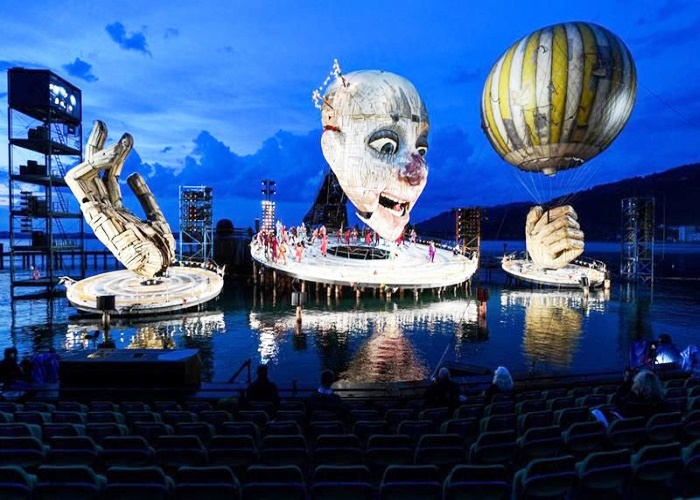Each year at the Bregenz Festival, a set designer creates an elaborate opera stage on the water

On July 17, the 74th season of Austria’s Bregenz Festival will begin, kicking off a monthlong celebration of opera. As in past summers, more than 200,000 people will descend on Bregenz, a lakeside city with about 29,500 people at the base of Pfänder mountain. Various performances—this season includes two versions of Don Quixote (one opera and one musical theater), a musical theater performance of François Sarhan’s Wunderwandelwelt, Arthur Schnitzler’s play La Ronde (which will also be performed as a concert), Tchaikovsky’s Eugene Onegin, and a series of performances called Musik & Poesie—take place in three different locations, and as is tradition, the prize show is performed nightly on a massive stage floating on Lake Constance, a nearly 40-mile-long lake at the foot of the Alps.
But the set for this year’s lakeside show—Rigoletto, a three-act Giuseppe Verdi tragic opera about a disfigured court jester trying to protect his daughter from a lecherous duke—is a bit different than the other spectacular stages preceeding it. Almost every single part of this stage moves.
“The challenge was really to invent something that’s not been seen here,” says this year’s stage director and designer, Philipp Stölzl. “That was a bit of a process; we threw our first idea into the trash can at some point and started again from scratch. We finally ended with a design that offers a lot of movement and transformation, which is really a fresh approach for Bregenz. Most of the previous productions have been rather static, more like sculptures.”
The very first Bregenz Festival happened in 1946, when the town didn’t even have its own theatre. Instead, the inaugural performance—Bastien et Bastienne—was performed on two barges moored on Lake Constance. One barge carried the stage, the other carried the orchestra.
The lake stage at the Bregenz Festival has come a long way since the inaugural event. In the 1991-1992 season, the set for Carmen appeared to emerge from a valley between mountains. Fidelio was performed in the 1995-1996 season, with a series of rowhouses stretched across the stage. The 2001-2002 season showed La Bohème, with a massive cafe table and chairs half-submerged in the water. The 2007-2008 show, Tosca, was set in front of a colorful projected eyeball; the stage made an appearance in James Bond movie Quantum of Solace. Aida came to Bregenz for the 2009-2010 season, perfomed under a half-deconstructed Statue of Liberty. Last season, Carmen was accentuated by two giant hands throwing a deck of cards into the air; the cards changed through projections as they appeared to fall.
But the set for Rigoletto takes design to the extreme, with a 45-foot-tall jester’s head flanked by two hands, one holding a balloon. Every part of the set moves except for the hand holding the balloon. To hold up the massive weight of the head (nearly 40 tons on its own, and hitting abut 150 tons with the machinery attached to make it move), the stage is built on 119 wood and steel piles driven almost 20 feet into the lakebed. The hand on the left, powered by a hydraulic swivel, moves like a human hand and opens to about 37 feet tall. The frill around the jester’s neck appears to ruffle in the wind. Speakers for the show are incorporated into the set: five in the head and two in the index finger of the right hand.
“Bregenz is what every set designer dreams of creating. Everybody wants to work at Bregenz,” said Es Devlin in a 2017 interview, when she designed that year’s Carmen set. “The photographs of Bregenz are now dispersed around the world. Because of social media, because of the internet, everybody knows—they know the big bust, they know the cafe table, these images have penetrated the culture.”
Stölzl’s career began as a stage designer’s assistant at the Munich Kammerspiele. He went on to direct music videos for Madonna and movies like North Face, Goethe!, and The Physician. But like many other stage designers, he always dreamed of working at the Bregenz Festival. “It offers such a wonderful combination of monumental scale, broad audience and creative ambition,” he says. Now he’s realizing his dream—and executing on a rather technical feat: a giant color-changing balloon that flies up into the sky with singers inside.